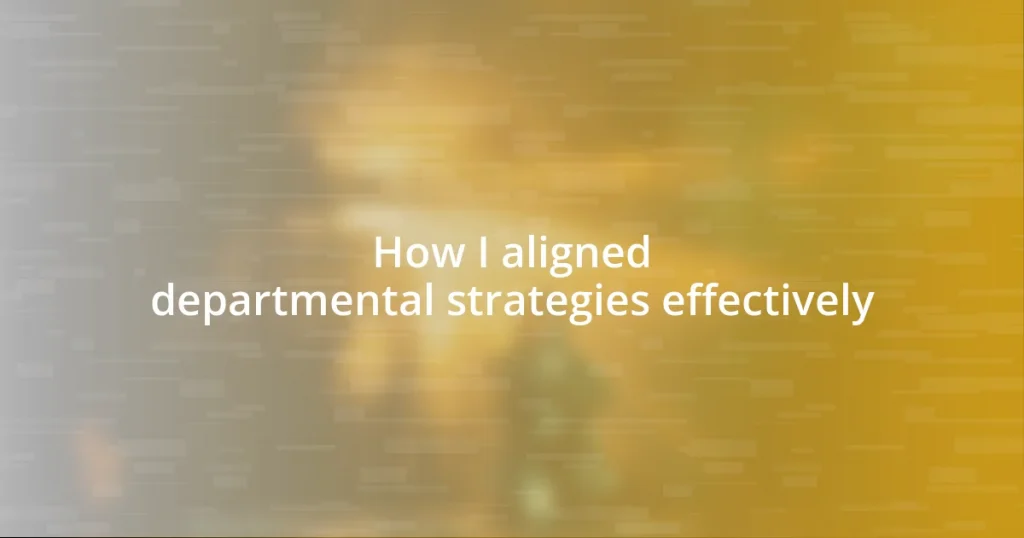Key takeaways:
- Aligning departmental strategies with overarching company objectives fosters collaboration and sparks innovation.
- Utilizing effective communication techniques, including storytelling and active listening, enhances engagement and builds trust among stakeholders.
- Celebrating successes and reflecting on lessons learned cultivates team morale and encourages ownership of individual contributions.

Understanding departmental strategies
Understanding departmental strategies involves recognizing the unique goals and functions of each team within an organization. During my time working in a marketing department, I learned that aligning our strategies with the overarching company objectives created clarity and motivation. Have you ever noticed how different teams operate in silos, often forgetting the common vision?
Every department, whether it’s finance, HR, or IT, has its own set of priorities, but these must connect cohesively to foster success. I remember a project where the sales and marketing teams clashed over their respective strategies, which led to missed opportunities. It was eye-opening to realize that mutual understanding between departments can spark innovation. Don’t you think that open dialogue could bridge those gaps too?
Furthermore, understanding departmental strategies isn’t just about acknowledging goals; it’s about weaving them into a collaborative fabric. I’ve seen firsthand the impact of brainstorming sessions where stakeholders from diverse departments share insights. It’s not just enlightening—it’s energizing! When departments share their individual strategies, it creates a more dynamic work environment. Don’t you find that when everyone’s on the same page, progress comes more naturally?

Identifying alignment opportunities
Identifying alignment opportunities begins with active listening and observation. I recall a team meeting where I noticed that the product development team’s timeline didn’t sync with marketing’s promotional schedule. By facilitating a casual conversation between both teams, we discovered we had intertwined goals but lacked the coordination needed for seamless execution. This experience taught me that alignment often lies in the spaces where departments intersect, waiting to be uncovered through open communication.
To streamline this process, consider these actionable steps:
- Actively listen to different departments’ objectives and challenges.
- Host cross-departmental brainstorming sessions to identify shared goals.
- Utilize surveys to gather insights about departmental perceptions and interdependencies.
- Create a visual map that showcases how each team’s goals contribute to larger organizational aims.
- Encourage informal meet-ups or discussions to foster relationships and understanding beyond formal meetings.
These strategies not only highlight potential alignment opportunities but also promote a culture of collaboration that I’ve found invaluable in my professional journey.

Communicating with stakeholders effectively
Effective communication with stakeholders is crucial for bridging gaps between departments. I remember a pivotal meeting where I realized that simply sharing information wasn’t enough; we had to engage stakeholders at a deeper level. I employed storytelling techniques to present our project updates, which made the data more relatable and compelling. Have you ever considered how narrative can turn dry statistics into a resonant message?
Another effective strategy I discovered was the importance of adapting my communication style to suit different stakeholders. For instance, presenting to technical teams required a more detailed, data-driven approach, while management appreciated concise summaries with actionable insights. This adaptability not only fostered understanding but also built trust. It’s fascinating how recognizing different perspectives creates a more inclusive dialogue, don’t you think?
Listening actively is just as vital as conveying information. I recall a particularly insightful feedback session where stakeholders voiced their concerns and aspirations. By validating their thoughts, we strengthened our relationships and refined our strategy accordingly. It became evident that when people feel heard, they are more likely to invest in the outcomes. Isn’t it rewarding when open lines of communication lead to collective success?
| Communication Strategy | Description |
|---|---|
| Storytelling | Engaging stakeholders through relatable narratives. |
| Adaptive Communication | Modifying presentation styles for different audiences. |
| Active Listening | Validating stakeholders’ feedback to enhance collaboration. |

Setting measurable goals together
Setting measurable goals together is a powerful method for fostering collaboration among departments. I recall a strategic planning workshop where we collectively brainstormed our priorities, using a simple framework to create SMART goals—specific, measurable, achievable, relevant, and time-bound. This process not only clarified our individual targets but also surfaced common objectives that truly energized the team. Have you ever experienced that kind of buzz when everyone is on the same page?
When we set these goals together, the sense of ownership is palpable. I remember a design team member passionately advocating for a goal that linked our user experience directly to customer satisfaction metrics. It was inspiring to see how their enthusiasm influenced the group, resulting in a shared commitment that transformed how we approached our projects. Why do you think this sense of ownership is so crucial for driving results?
Moreover, tracking progress towards these goals creates an environment of accountability. I implemented regular check-ins where we celebrated small wins and reflected on challenges. For instance, we once adjusted a goal after realizing it wasn’t realistic given our resources. This openness not only improved morale but also allowed us to pivot effectively, demonstrating that adaptation can be just as valuable as the original goal. Isn’t it refreshing to know that flexibility can coexist with commitment?

Utilizing collaboration tools
Utilizing collaboration tools has been a game changer in aligning departmental strategies. I vividly remember when we integrated a project management tool that allowed real-time updates and shared task lists. Suddenly, everyone had visibility into each other’s work, leading to a collaborative spirit that felt almost electric. Have you felt that surge of motivation when collaboration reaches new heights?
One of my favorite tools, a digital whiteboard, transformed our brainstorming sessions. It was fascinating to watch ideas flow freely among team members as we visualized our thoughts and organized them in real-time. The creative energy in the room was palpable, and it became clear that everyone appreciated the inclusive approach. Isn’t it amazing how simplicity can drive innovation?
Another important aspect is choosing the right collaboration tool for your team’s culture. I recall a time when we switched to a messaging platform that encouraged casual check-ins, and it became the heartbeat of our project. Those quick conversations—often sprinkled with humor—helped strengthen our relationships and made tackling challenges easier. Do you think fostering informal connections can lead to more innovative solutions?

Monitoring progress and making adjustments
Monitoring progress and making adjustments is essential in ensuring our strategies remain effective and relevant. I recall a specific instance when we set up a centralized dashboard for tracking our progress toward goals. I felt a sense of clarity as I watched the numbers change, reflecting our efforts in real-time. It wasn’t just data; it was a narrative of our team’s journey. Have you ever felt that rush when you see your hard work yielding visible results?
During our weekly review meetings, we encouraged an open dialogue about what was working and what wasn’t. I remember one particular discussion where a marketing team member voiced their concerns about a campaign’s effectiveness. Instead of seeing this as a setback, we viewed it as an opportunity to pivot. By being willing to adapt our strategy based on feedback, we turned potential disappointments into collaborative problem-solving sessions. Isn’t it remarkable how addressing concerns head-on can lead to innovative solutions?
Moreover, I’ve learned that making timely adjustments is just as important as monitoring progress. I had a project where we initially aimed for an ambitious launch date, but as we tracked our workload, it became clear we were at risk of burning out. I proposed a revised timeline that considered our team’s capacity, which not only eased the pressure but increased our long-term productivity. Isn’t it empowering to know that recognizing when to recalibrate can ultimately lead to a more successful outcome?

Celebrating successes and reflecting
Celebrating successes and reflecting on them is a vital part of any team’s journey. After completing a challenging project, I organized a small celebration with my team. It was a simple gathering, yet the joy in the room was contagious—everyone shared their contributions, and I could feel the pride radiating from each individual. Isn’t it incredible how recognizing achievements, no matter how small, can foster a deeper connection within a team?
Reflecting on our successes also opened doors for personal growth. I remember when we wrapped up an annual campaign that exceeded our expectations. Each of us had our distinct roles, and during our debrief, I was amazed at how sharing our individual lessons learned ignited a discussion about future strategies. Reflection isn’t just about celebrating; it’s about uncovering insights that shape our path forward. Have you ever found that those moments of quiet reflection held the key to your next big idea?
In my experience, a mix of celebration and reflection can significantly boost team morale and engagement. After one particularly lengthy project, we established a tradition of sharing “victory moments” in our team meetings. I was always inspired by hearing how personal efforts contributed to our collective success. This practice not only highlighted achievements but encouraged everyone to take ownership of their work. Don’t you think acknowledging these moments can transform the way we view teamwork?















